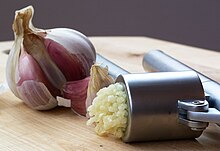

A garlic press, also known as a garlic crusher, is a kitchen utensil to crush garlic cloves efficiently by forcing them through a grid of small holes, usually with some type of piston. Many garlic presses also have a device with a matching grid of blunt pins to clean out the holes.
Contents
The first patent for a garlic press is credited to Karl Zysset (1907–1988) founder of the Swiss kitchen utensil company Zyliss, though the design is functionally identical to earlier presses that were in widespread use. [1] [2]
Garlic presses present a convenient alternative to mincing garlic with a knife, especially because a clove of garlic can be passed through a sturdy press without even removing its peel. The peel remains in the press while the garlic is extruded out. Some sources [3] also claim that pressing with the peel on makes cleaning the press easier.
Garlic crushed by a press is generally believed[ citation needed ] to have a different flavor from minced garlic, more of garlic's strong flavor compounds are liberated. A few sources prefer the flavor of pressed garlic. Raw-foods chef Renée Underkoffler says "a good garlic press makes dealing with garlic a clean pleasure. Pressed garlic has a lighter, more delicate flavor than minced garlic because it excludes the bitter center stem." [4] The magazine Cook's Illustrated says "a good garlic press can break down cloves more finely and evenly than an average cook using a knife, which means better distribution of garlic flavor throughout any given dish." [5]
On the other hand, some chefs say garlic crushed in a press has an inferior flavor compared to other forms of garlic. For instance, chef Anthony Bourdain called garlic presses "abominations" and advised "don't put it through a press. I don't know what that junk is that squeezes out of the end of those things, but it ain't garlic." [6] The cookery writer Elizabeth David wrote an essay titled "Garlic Presses are Utterly Useless". [7] Alton Brown (known for his dislike of single-purpose kitchen tools) has referred to garlic presses as "useless" and without a reason to exist. [8]
Cook's Illustrated lists some additional uses for a garlic press, such as mashing other small items (including olives, capers, anchovies, ginger and canned chipotles) or pressing out small quantities of onion or shallot juice. [5]